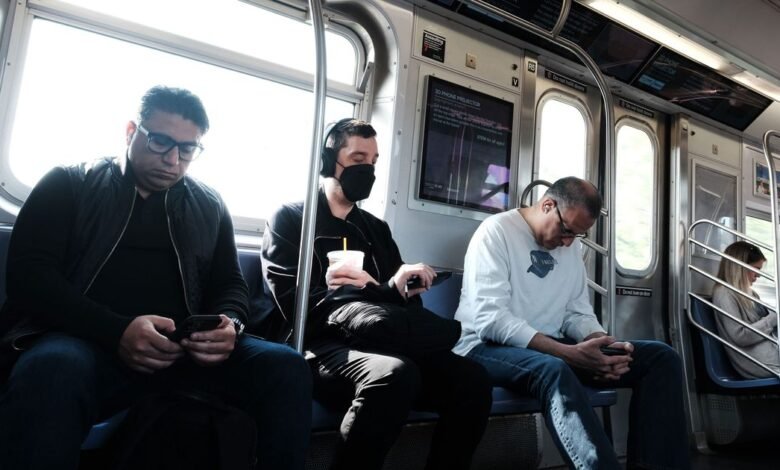Why Is the CDC Now Treating COVID Like It’s the Flu?


Photo: Spencer Platt/Getty Images
The Centers for Disease Control and Prevention on Friday mothballed its longstanding COVID isolation guidance, announcing that people no longer need to isolate for five days after catching the coronavirus. Instead, per the CDC, they should stay home if they feel sick but can leave home and resume normal activities as soon as their symptoms are getting better and its been a day since they had a fever (without the help of fever-reducing medication). That means that the CDC is now both streamlining and simplifying its recommendations and advising people to treat their COVID infections like they would the flu or any other respiratory illness — even though the novel coronavirus is nothing like the flu or other common respiratory viruses.
Many public-health experts are backing the move, which is the first major change the CDC has made to the guidance since it reduced the isolation period from ten days to five in late 2021 and had been previewed last month in a report by the Washington Post. The CDC and the experts supporting the plan have noted that it makes sense for the agency to align its isolation guidance with how everyone is now living with COVID, four years after the start of the pandemic. That new normal is that COVID isn’t going away and people are still catching it, but the threat it poses and harm is causes continues to decline thanks to virtually everyone having some form of immunity owing to prior infection or the administration of widely available vaccines, in addition to the availability of effective life-saving antiviral treatments like Paxlovid.
The CDC says that COVID was the tenth leading cause of death in the U.S. in 2023, down from being the third leading cause of death in 2020 and 2021 (behind heart disease and cancer), and the fourth leading cause in 2022 (behind heart disease, cancer, and unintentional injuries like car accidents and drug overdoses). Weekly hospital admissions have dropped more than 75 percent since the peak of the Omicron wave in early 2022. And at least so far, no new variants have emerged that have been able to pierce our collective wall of immunity against severe COVID.
Public-health authorities in Europe, Australia, and Canada have already lifted their COVID isolation requirements, as have California and Oregon — and there haven’t been significant spikes in COVID hospitalizations in those two states following the policy changes, as a CDC official noted Friday.
The new CDC guidelines also reflect the all-too-obvious reality that the general public’s attitudes toward COVID have changed enormously over the past couple years, and at this point it’s not at all clear how many were still following the CDC’s old test-and-isolate guidelines anyway. Less than half of the respondents to a recent CDC survey said they would get a COVID test if they had coldlike symptoms. As infectious-disease expert Dr. Céline Gounder pointed out to the New York Times on Friday, the lack of testing alone necessitated a policy change: “If you don’t know which virus you have, how are you supposed to follow the right guidance for COVID versus flu versus RSV versus the common-cold virus?”
Another well-known issue is that research has long indicated that COVID is mostly spread by people who have asymptomatic infections and thus probably never knew they had it and should isolate. People with COVID are often contagious before they develop symptoms as well.
To be clear, the CDC has not yet dialed back its longer isolation guidelines for health-care and nursing-home workers. And the agency still stresses the importance of being fully vaccinated and boosted and says anyone with additional risk factors — seniors, infants, and people with preexisting medical conditions — should get tested as soon as they develop symptoms of a respiratory illness and, if necessary, receive anti-viral treatments that target whichever one they’ve got. Last week, the CDC newly recommended that everyone 65 and older should definitely get another booster shot this spring. Seniors are still suffering the brunt of COVID-19’s worst health impacts, and the agency says 95 percent of the people hospitalized for COVID in the U.S. this winter had not received the most-recent booster shot.
Also while its “sunsetting” the multiday isolation policy, the CDC now advises people recovering from COVID or another respiratory illness to take additional steps, for five days, to reduce the risk of passing it on to others since they might still be contagious. The agency said despite feeling better, people should limit close contact with others, wear a well-fit N95 or equivalent high-filtration face mask while in public, cover their mouth when they cough or sneeze, practice good hygiene like regular hand and surface washing, and work to improve ventilation and air quality in enclosed indoor spaces. If everyone actually did all that whenever they felt sick, it would undoubtedly reduce the transmission of all respiratory viruses, not just COVID — and both prevent a lot of misery and save a lot of lives.
“Our goal here is to continue to protect those at risk for severe illness while also reassuring folks that these recommendations are simple, clear, easy to understand, and can be followed,” CDC director Dr. Mandy Cohen explained in a briefing on Friday. “We wanted to give folks simple, actionable things that they can remember and do in order to protect themselves.”
This is all part of the CDC’s new “Pan-respiratory” approach to battling COVID, the flu, and RSV all at the same time. The agency began formulating this plan in August and is now ready to launch the new approach after monitoring the latest respiratory-illness season. “We wanted to see continued decreases in hospitalizations, decreases in deaths, even with that larger change in the virus,” Cohen said.
Most state-level public-health authorities are already aligning their recommendations with the new CDC guidance, but it’s not yet clear how, or how quickly, schools and employers will incorporate the new advice into their COVID policies (if they still had them). The CDC says it will soon revise its guidance for schools as well.
Some public-health experts had already been calling for the CDC to ditch its isolation advisory, which critics saw as ineffective and increasingly out of touch. Now that the new guidance is out, it’s gotten plenty of support. The Infectious Diseases Society of America released a statement backing the plan, and former FDA commissioner Scott Gottlieb — who has criticized the CDC and U.S. pandemic response on many other occasions — is onboard as well:
Some public-health experts have criticized the new guidelines, however, or at least expressed their concerns about the new normal they represent. Dr. Gounder, for instance, told the Times that she supported the new policy but also pointed out how it was yet another way COVID risk management was getting outsourced from the government to the general public:
Little has been done to improve indoor air quality in most places, and wearing masks can be socially uncomfortable for many people, Dr. Gounder said. “This is again putting a lot of burden on the individual to do the right thing by public health,” she said. Making masks affordable and providing them in public spaces and workplaces would help people follow the new guidelines, she added.
Jennifer Nuzzo, who directs the Pandemic Center at Brown’s School of Public Health, also notes that the old CDC isolation guidance, when translated into official policy by employers, protected workers — at least at the workplaces that still offered five paid sick days following a positive COVID test. “My biggest worry in all of this is that employers will take this change in guidance to require employees to come back to work … before they are ready to, before they feel well enough, and before they are not likely to pose harm to their co-workers,” she told the Associated Press.
The People’s CDC, a group of health-care workers and researchers who generally support more aggressive approaches to battling COVID than the CDC has ever taken, opposes the plan and says that the agency’s new guidance is more about aligning with corporate priorities than public-health ones. After news of the updated guidelines first came out last month, the group began organizing against it:
The five-day period is the minimum amount of time for some people while for others a ten to fourteen day period is needed when infected by COVID to rest and recover from illness and prevent the exposure and spread of COVID to uninfected people. A ten-day period is better to ensure an adequate amount of time for rest and recovery.
The disabled could face further challenges as a result of change too, American Association of People with Disabilities president Maria Town warned the Washington Post:
Our community has been really left behind and disposable for the past four years, and this is yet another reminder of that. Grouping all three of these viruses together fails to recognize how much more contagious COVID is, how it behaves differently and puts many people, especially disabled people and immunocompromised people, at risk.
Others see the new CDC stance as a retreat from hard-learned COVID science. Per CNN:
“It’s not good science. It’s not good public health. It doesn’t provide people with accurate information,” [said Dr. Ellie Murray, an assistant professor of epidemiology at Boston University’s School of Public Health. She] notes that we’ve learned a lot about how respiratory diseases spread and how best to control them during the pandemic. But instead of applying those lessons to help protect people from other infections like the flu, she says, this rolling back of precautions is sending a harmful message.
“It’s undermining the whole rest of the public health system,” she said. “Because what people are hearing is, ‘Actually, diseases aren’t as bad as we’d said they were, and we don’t actually need to do anything. It’s not actually that bad if some people die.’”
Scripps’ Dr. Eric Topol told CNN that treating COVID like other respiratory illnesses was a mistake:
I completely disagree with the idea there is no COVID exceptionalism. The overwhelmingly abundant evidence for this virus over the past 4 years tells us that it is a far more dangerous pathogen than flu, which lacks seasonality, is still evolving, has induced Long Covid in tens of millions of throughout the worlds, and cannot be ‘FLU-ified.’
A few days before the CDC announced the new isolation guidance, the Atlantic’s Katherine J. Wu reported on the many potential downsides of COVID flu-ification:
COVID and the flu are nowhere near the same. SARS-CoV-2 still spikes in non-winter seasons and simmers throughout the rest of the year. In 2023, COVID hospitalized more than 900,000 Americans and killed 75,000; the worst flu season of the past decade hospitalized 200,000 fewer people and resulted in 23,000 fewer deaths. A recent CDC survey reported that more than 5 percent of American adults are currently experiencing long COVID, which cannot be fully prevented by vaccination or treatment, and for which there is no cure. Plus, scientists simply understand much less about the coronavirus than flu viruses. Its patterns of spread, its evolution, and the durability of our immunity against it all may continue to change.
And yet, the CDC and White House continue to fold COVID in with other long-standing seasonal respiratory infections. When the nation’s authorities start to match the precautions taken against COVID with those for flu, RSV, or common colds, it implies “that the risks are the same,” Saskia Popescu, an epidemiologist at the University of Maryland, told me. Some of those decisions are “not completely unreasonable,” says Costi Sifri, the director of hospital epidemiology at UVA Health, especially on a case-by-case basis. But taken together, they show how bent America has been on treating COVID as a run-of-the-mill disease — making it impossible to manage the illness whose devastation has defined the 2020s.
Wu also highlighted how encouraging less testing — which the new CDC guidance seems likely to do — could lead to less effective treatment:
The less people test, the less they’ll be diagnosed — and the less they’ll benefit from antivirals such as Paxlovid, which work best when administered early. Sifri worries that this pattern could yield another parallel to flu, for which many providers hesitate to prescribe Tamiflu, debating its effectiveness. Paxlovid use is already shaky; both antivirals may end up chronically underutilized.
Flu-ification also threatens to further stigmatize long COVID. Other respiratory infections, including flu, have been documented triggering long-term illness, but potentially at lower rates, and to different degrees than SARS-CoV-2 currently does. Folding this new virus in with the rest could make long COVID seem all the more negligible. What’s more, fewer tests and fewer COVID diagnoses could make it much harder to connect any chronic symptoms to this coronavirus, keeping patients out of long-COVID clinics — or reinforcing a false portrait of the condition’s rarity.
But Dr. Ashish Jha, the former U.S. COVID response coordinator, argues in an X thread that the new CDC guidelines also account for real-world costs and benefits in a way that all good public-health guidance should:
The question is not whether guidance will have benefits. If we only focused on benefit, public health would recommend you never drive over 30 MPH, ever drink alcohol (no amount is safe!), ever eat bacon (class 1 carcinogen!!), and so on. But those would be bad recommendations. Instead, good guidance weighs burden and benefit. If you can’t work from home or have kids to care for, the burden of isolation is real. That burden was worth it in 2020: isolation made sense because the cost of infections was so high — hospitalizations, deaths, Long COVID.
In 2024, that burden of isolation hasn’t changed, but the benefit has — it just matters far less. 98 percent of the population has at least some immunity, incidence of Long COVID is way down, and we have widely available effective treatments for high risk folks. So the CDC is updating its guidance, not because the “science” has changed, not because they only recommend what people are willing to do, but because the burden/benefit calculus has changed. A lot.
As Jha and others stress, nothing about the science of COVID has changed. It’s not the flu, and anyone who thinks they might have COVID should absolutely respect the danger it still poses, particularly to others. What has changed, for the better, is how much harm it’s doing to the public’s overall health — and that’s what the CDC is continuing to point to as its public-health messaging around COVID evolves.
This post has been updated.





